What Is 70 Euros In Us Dollars
| United states of america dollar | |||||
|---|---|---|---|---|---|
| |||||
| ISO 4217 | |||||
| Code | USD | ||||
| Number | 840 | ||||
| Exponent | 2 | ||||
| Denominations | |||||
| Superunit | |||||
| x | Eagle | ||||
| Subunit | |||||
| 1⁄ten | Dime | ||||
| 1⁄100 | Cent | ||||
| 1⁄1000 | Mill | ||||
| Symbol | $, US$, U$ | ||||
| Cent | ¢ | ||||
| Mill | ₥ | ||||
| Nickname | Listing of nicknames
| ||||
| Banknotes | |||||
| Freq. used | $ane, $5, $10, $20, $l, $100 | ||||
| Rarely used | $2 (still printed); $500, $one,000, $5,000, $10,000 (discontinued, even so legal tender) | ||||
| Coins | |||||
| Freq. used | 1¢, 5¢, 10¢, 25¢ | ||||
| Rarely used | l¢, $i (still minted); ½¢ two¢, 3¢ (Nickel); 3¢ (silvery, discontinued but however legal tender); 20¢, $ii.50, $3, $20 (discontinued, however legal tender); $5, $ten (legal tender, now commemorative only) | ||||
| Demographics | |||||
| Date of introduction | Apr 2, 1792 (1792-04-02) | ||||
| Source | [1] | ||||
| Replaced | Continental currency Diverse foreign currencies, including: Pound sterling Spanish dollar | ||||
| User(s) | ix dependent territories
eight other countries
| ||||
| Issuance | |||||
| Fundamental depository financial institution | Federal Reserve | ||||
| Website | federalreserve | ||||
| Printer | Bureau of Engraving and Printing | ||||
| Website | moneyfactory | ||||
| Mint | United States Mint | ||||
| Website | usmint | ||||
| Valuation | |||||
| Inflation | 8.3% | ||||
| Source | BLS, April 2022 | ||||
| Method | CPI | ||||
| Pegged by | 35 currencies
| ||||
The United States dollar (symbol: $; code: USD; also abbreviated US$ or U.S. Dollar, to distinguish it from other dollar-denominated currencies; referred to as the dollar, U.S. dollar, American dollar, or colloquially buck) is the official currency of the The states and several other countries. The Coinage Deed of 1792 introduced the U.S. dollar at par with the Spanish silver dollar, divided it into 100 cents, and authorized the minting of coins denominated in dollars and cents. U.S. banknotes are issued in the form of Federal Reserve Notes, popularly chosen greenbacks due to their predominantly green colour.
The monetary policy of the United States is conducted by the Federal Reserve System, which acts every bit the nation's central bank.
The U.S. dollar was originally defined under a bimetallic standard of 371.25 grains (24.057 g) (0.7735 troy ounces) fine argent or, from 1837, 23.22 grains (1.505 g) fine gold, or $20.67 per troy ounce. The Gilt Standard Act of 1900 linked the dollar solely to gold. From 1934, its equivalence to gold was revised to $35 per troy ounce. Since 1971 all links to gold take been repealed.[7]
The U.S. dollar became an important international reserve currency after the Offset Earth State of war, and displaced the pound sterling as the world'due south primary reserve currency by the Bretton Woods Agreement towards the end of the Second World War. The dollar is the nigh widely used currency in international transactions,[8] and a gratis-floating currency. It is also the official currency in several countries and the de facto currency in many others,[9] [ten] with Federal Reserve Notes (and, in a few cases, U.Due south. coins) used in circulation.
As of February x, 2021, currency in circulation amounted to Usa$2.ten trillion, $ii.05 trillion of which is in Federal Reserve Notes (the remaining $50 billion is in the form of coins and older-manner U.s.a. Notes).[11]
Overview [edit]
In the Constitution [edit]
Article I, Department 8 of the U.Southward. Constitution provides that Congress has the power "[t]o coin money."[12] Laws implementing this ability are currently codified in Title 31 of the U.S. Lawmaking, under Section 5112, which prescribes the forms in which the United States dollars should be issued.[13] These coins are both designated in the department as "legal tender" in payment of debts.[13] The Sacagawea dollar is one example of the copper alloy dollar, in contrast to the American Silverish Eagle which is pure silver. Section 5112 too provides for the minting and issuance of other coins, which have values ranging from one cent (U.S. Penny) to 100 dollars.[13] These other coins are more than fully described in Coins of the United States dollar.
Article I, Section 9 of the Constitution provides that "a regular Statement and Account of the Receipts and Expenditures of all public Coin shall be published from time to time,"[14] which is farther specified by Section 331 of Title 31 of the U.South. Lawmaking.[15] The sums of money reported in the "Statements" are currently expressed in U.South. dollars, thus the U.Due south. dollar may be described as the unit of account of the United states of america.[16] "Dollar" is one of the first words of Section 9, in which the term refers to the Spanish milled dollar, or the money worth eight Spanish reales.
The Coinage Act [edit]
In 1792, the U.South. Congress passed the Coinage Act, of which Section ix authorized the product of various coins, including:[17] : 248
Dollars or Units—each to be of the value of a Castilian milled dollar as the same is now current, and to contain three hundred and seventy-ane grains and four sixteenth parts of a grain of pure, or 4 hundred and sixteen grains of standard silvery.
Section xx of the Act designates the United States dollar as the unit of currency of the United States:[17] : 250–ane
[T]he coin of business relationship of the U.s. shall be expressed in dollars, or units…and that all accounts in the public offices and all proceedings in the courts of the United States shall be kept and had in conformity to this regulation.
Decimal units [edit]
Dissimilar the Spanish milled dollar, the Continental Congress and the Coinage Human activity prescribed a decimal system of units to go with the unit dollar, equally follows:[18] [19] the manufactory, or one-thousandth of a dollar; the cent, or one-hundredth of a dollar; the dime, or one-tenth of a dollar; and the eagle, or ten dollars. The electric current relevance of these units:
- Just the cent (¢) is used as everyday division of the dollar.
- The dime is used solely as the proper name of the coin with the value of x cents.
- The manufactory (₥) is relatively unknown, but before the mid-20th century was familiarly used in matters of sales taxes, as well as gasoline prices, which are usually in the class of $ΧΧ.ΧΧ9 per gallon (east.chiliad., $3.599, normally written as $3.59+ 9⁄x ).[20] [21]
- The hawkeye is also largely unknown to the general public.[21] This term was used in the Coinage Act of 1792 for the denomination of ten dollars, and later was used in naming gold coins.
The Spanish peso or dollar was historically divided into 8 reales (colloquially, bits) - hence pieces of viii. Americans also learned counting in non-decimal bits of 12 i⁄2 cents before 1857 when Mexican bits were more frequently encountered than American cents; in fact this practice survived in New York Stock Exchange quotations until 2001.[22] [23]
In 1854, Secretary of the Treasury James Guthrie proposed creating $100, $50, and $25 gold coins, to be referred to as a union, half union, and quarter union, respectively,[24] thus implying a denomination of ane Union = $100. However, no such coins were ever struck, and simply patterns for the $l half union exist.
When currently issued in circulating course, denominations less than or equal to a dollar are emitted as U.S. coins, while denominations greater than or equal to a dollar are emitted equally Federal Reserve Notes, disregarding these special cases:
- Golden coins issued for circulation until the 1930s, up to the value of $xx (known equally the double hawkeye)
- Bullion or commemorative gold, silver, platinum, and palladium coins valued upwards to $100 equally legal tender (though worth far more than as bullion).
- Ceremonious War newspaper currency issue in denominations below $1, i.due east. fractional currency, sometimes pejoratively referred to as shinplasters.
Etymology [edit]
In the 16th century, Count Hieronymus Schlick of Bohemia began minting coins known every bit joachimstalers, named for Joachimstal, the valley in which the silver was mined. In turn, the valley's name is titled after Saint Joachim, whereby thal or tal, a cognate of the English language word dale, is German for 'valley.'[25] The joachimstaler was later shortened to the German language taler, a discussion that somewhen found its way into many languages, including:[25] tolar (Czech, Slovak and Slovene); daler (Danish and Swedish); dalar and daler (Norwegian); daler or daalder (Dutch); talari (Ethiopian); tallér (Hungarian); tallero (Italian); دولار (Arabic); and dollar (English).
Though the Dutch pioneered in modern-24-hour interval New York in the 17th century the utilize and the counting of money in silver dollars in the grade of High german-Dutch reichsthalers and native Dutch leeuwendaalders ('lion dollars'), it was the ubiquitous Spanish American eight-real coin which became exclusively known as the dollar since the 18th century.[26]
Nicknames [edit]
The colloquialism cadet(s) (much like the British quid for the pound sterling) is ofttimes used to refer to dollars of various nations, including the U.S. dollar. This term, dating to the 18th century, may have originated with the colonial leather trade, or it may as well take originated from a poker term.[27]
Greenback is another nickname, originally applied specifically to the 19th-century Demand Note dollars, which were printed blackness and green on the backside, created by Abraham Lincoln to finance the Northward for the Civil War.[28] It is still used to refer to the U.Due south. dollar (but not to the dollars of other countries). The term greenback is as well used by the financial printing in other countries, such as Commonwealth of australia,[29] New Zealand,[30] Due south Africa,[31] and India.[32]
Other well-known names of the dollar as a whole in denominations include greenmail , green , and expressionless presidents , the latter of which referring to the deceased presidents pictured on almost bills. Dollars in general have besides been known as bones (east.g. "twenty basic" = $20). The newer designs, with portraits displayed in the main body of the obverse (rather than in cameo insets), upon paper color-coded by denomination, are sometimes referred to equally bigface notes or Monopoly money .
Piastre was the original French word for the U.S. dollar, used for example in the French text of the Louisiana Purchase. Though the U.S. dollar is called dollar in Mod French, the term piastre is still used amid the speakers of Cajun French and New England French, every bit well as speakers in Haiti and other French-speaking Caribbean islands.
Nicknames specific to denomination:
- The quarter dollar coin is known as two bits, betraying the dollar'due south origins every bit the "piece of eight" (bits or reales).[22]
- The $ane bill is nicknamed cadet or single.
- The infrequently-used $2 neb is sometimes called deuce, Tom, or Jefferson (after Thomas Jefferson).
- The $v nib is sometimes called Lincoln, fin, fiver, or 5-spot.
- The $10 bill is sometimes called sawbuck, ten-spot, or Hamilton (after Alexander Hamilton).
- The $20 nib is sometimes called double sawbuck, Jackson (after Andrew Jackson), or double eagle.
- The $50 beak is sometimes called a yardstick, or a grant, after President Ulysses S. Grant.
- The $100 bill is called Benjamin, Benji, Ben, or Franklin, referring to its portrait of Benjamin Franklin. Other nicknames include C-annotation (C being the Roman numeral for 100), century notation, or bill (e.thou. two bills = $200).
- Amounts or multiples of $1,000 are sometimes called 1000 in vernacular speech, abbreviated in written grade to G, 1000, or grand (from kilo; e.g. $10k = $10,000). Likewise, a large or stack can as well refer to a multiple of $i,000 (e.g. "fifty large" = $fifty,000).
Dollar sign [edit]
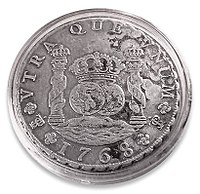
The symbol $, usually written earlier the numerical amount, is used for the U.S. dollar (likewise as for many other currencies). The sign was the upshot of a late 18th-century evolution of the scribal abridgement ps for the peso, the common name for the Spanish dollars that were in broad circulation in the New Globe from the 16th to the 19th centuries. The p and the s eventually came to be written over each other giving rise to $ .[33] [34] [35] [36]
Some other popular explanation is that it is derived from the Pillars of Hercules on the Castilian Coat of arms of the Castilian dollar. These Pillars of Hercules on the silver Spanish dollar coins have the form of two vertical bars (||) and a swinging cloth ring in the shape of an S .
Yet another explanation suggests that the dollar sign was formed from the capital letters U and Southward written or printed one on top of the other. This theory, popularized past novelist Ayn Rand in Atlas Shrugged,[37] does non consider the fact that the symbol was already in use before the formation of the United States.[38]
History [edit]
Origins: the Spanish dollar [edit]
The U.S. dollar was introduced at par with the Spanish-American silvery dollar (or Spanish peso, Castilian milled dollar, eight-real coin, piece-of-eight). The latter was produced from the rich silver mine output of Spanish America; minted in United mexican states City, Potosí (Bolivia), Lima (Peru) and elsewhere; and was in wide circulation throughout the Americas, Asia and Europe from the 16th to 19th centuries. The minting of machine-milled Spanish dollars since 1732 boosted its worldwide reputation every bit a trade coin and positioned it to be model for the new currency of the The states.
Fifty-fifty after the Us Mint commenced issuing coins in 1792, locally minted dollars and cents were less abundant in circulation than Spanish American pesos and reales; hence Spanish, Mexican and American dollars all remained legal tender in the United States until the Coinage Deed of 1857. In item, Colonists' familiarity with the Spanish 2-real quarter peso was the reason for issuing a quasi-decimal 25-cent quarter dollar coin rather than a 20-cent coin.
For the relationship between the Spanish dollar and the private state colonial currencies, see Connecticut pound, Delaware pound, Georgia pound, Maryland pound, Massachusetts pound, New Hampshire pound, New Jersey pound, New York pound, North Carolina pound, Pennsylvania pound, Rhode Island pound, South Carolina pound, and Virginia pound.
Coinage Act of 1792 [edit]

Alexander Hamilton finalized the details of the 1792 Coinage Act and the establishment of the U.Southward. Mint.
On the 6th of July 1785, the Continental Congress resolved that the money unit of the United States, the dollar, would contain 375.64 grains of fine argent; on the eighth of August 1786, the Continental Congress continued that definition and further resolved that the money of business relationship, corresponding with the partitioning of coins, would continue in a decimal ratio, with the sub-units being mills at 0.001 of a dollar, cents at 0.010 of a dollar, and dimes at 0.100 of a dollar.[xviii]
After the adoption of the Us Constitution, the U.S. dollar was defined past the Coinage Act of 1792. It specified a "dollar" based on the Castilian milled dollar to contain 371 iv⁄16 grains of fine silver, or 416.0 grains (26.96 g) of "standard silvery" of fineness 371.25/416 = 89.24%; as well every bit an "eagle" to contain 247 iv⁄8 grains of fine golden, or 270.0 grains (17.50 k) of 22 karat or 91.67% fine gold.[39] Alexander Hamilton arrived at these numbers based on a treasury assay of the average fine silver content of a choice of worn Castilian dollars, which came out to be 371 grains. Combined with the prevailing golden-silver ratio of fifteen, the standard for gold was calculated at 371/15 = 24.73 grains fine gold or 26.98 grains 22K gold. Rounding the latter to 27.0 grains finalized the dollar's standard to 24.75 grains of fine gold or 24.75*15 = 371.25 grains = 24.0566 grams = 0.7735 troy ounces of fine silver.
The same coinage human activity besides set the value of an eagle at x dollars, and the dollar at 1⁄10 eagle. Information technology chosen for silver coins in denominations of 1, 1⁄two , 1⁄iv , 1⁄ten , and 1⁄20 dollar, as well equally gold coins in denominations of 1, i⁄two and 1⁄four hawkeye. The value of gold or silver contained in the dollar was then converted into relative value in the economy for the buying and selling of appurtenances. This allowed the value of things to remain fairly constant over time, except for the influx and outflux of aureate and silver in the nation's economic system.[40]
Though a Spanish dollar freshly minted later on 1772 theoretically contained 417.7 grains of silvery of fineness 130/144 (or 377.1 grains fine silver), reliable assays of the period in fact confirmed a fine silver content of 370.95 grains (24.037 g) for the average Spanish dollar in circulation. [41] The new U.Southward. argent dollar of 371.25 grains (24.057 chiliad) therefore compared favorably and was received at par with the Spanish dollar for foreign payments, and after 1803 the The states Mint had to suspend making this coin out of its express resources since it failed to stay in domestic circulation. It was only afterwards Mexican independence in 1821 when their peso'south fine silvery content of 377.ane grains was firmly upheld, which the U.S. later had to compete with using a heavier 378.0 grains (24.49 g) Merchandise dollar money.
Blueprint [edit]
The early currency of the Us did not exhibit faces of presidents, as is the custom now;[42] although today, past law, only the portrait of a deceased individual may appear on U.s. currency.[43] In fact, the newly formed government was confronting having portraits of leaders on the currency, a practise compared to the policies of European monarchs.[44] The currency every bit we know it today did not get the faces they currently have until after the early 20th century; before that "heads" side of coinage used profile faces and striding, seated, and continuing figures from Greek and Roman mythology and composite Native Americans. The last coins to exist converted to profiles of historic Americans were the dime (1946) and the Dollar (1971).
Continental currency [edit]

Continental one 3rd dollar nib (obverse)
Later the American Revolution, the 13 colonies became contained. Freed from British budgetary regulations, they each issued £sd paper money to pay for armed services expenses. The Continental Congress also began issuing "Continental Currency" denominated in Castilian dollars. For its value relative to states' currencies, run into Early American currency.
Continental currency depreciated badly during the war, giving rising to the famous phrase "not worth a continental".[45] A primary problem was that monetary policy was not coordinated between Congress and the states, which connected to effect bills of credit. Additionally, neither Congress nor the governments of the several states had the will or the ways to retire the bills from circulation through taxation or the sale of bonds.[46] The currency was ultimately replaced past the silver dollar at the charge per unit of ane silver dollar to k continental dollars. It gave rise to the phrase "not worth a continental", and was responsible for the clause in article 1, department 10 of the U.s.a. Constitution which reads: "No state shall... brand anything but golden and silver coin a tender in payment of debts".
Silver and gold standards, 19th century [edit]
From implementation of the 1792 Mint Act to the 1900 implementation of the gold standard the dollar was on a bimetallic silverish-and-gold standard, divers as either 371.25 grains (24.056 g) of fine silver or 24.75 grains of fine gilded (aureate-silver ratio 15).
Subsequent to the Coinage Human action of 1834 the dollar's fine aureate equivalent was revised to 23.two grains; it was slightly adjusted to 23.22 grains (one.505 thou) in 1837 (gold-argent ratio ~sixteen). The same deed as well resolved the difficulty in minting the "standard argent" of 89.24% fineness past revising the dollar's alloy to 412.5 grains, 90% silver, still containing 371.25 grains fine silver. Gilded was also revised to ninety% fineness: 25.8 grains gross, 23.22 grains fine gold.
Following the rise in the price of argent during the California Gilt Rush and the disappearance of circulating silvery coins, the Coinage Act of 1853 reduced the standard for silvery coins less than $1 from 412.5 grains to 384 grains (24.9 g), ninety% argent per 100 cents (slightly revised to 25.0 g, 90% silver in 1873). The Act also express the free silver right of individuals to convert bullion into only one coin, the silver dollar of 412.5 grains; smaller coins of lower standard tin can only be produced by the United States Mint using its own bullion.
Summary and links to coins issued in the 19th century:
- In base metallic: ane/2 cent, 1 cent, 5 cents.
- In silver: half dime, dime, quarter dollar, half dollar, silver dollar.
- In gold: gold $i, $two.50 quarter eagle, $five one-half eagle, $10 hawkeye, $20 double eagle
- Less common denominations: bronze 2 cents, nickel 3 cents, silverish three cents, silver 20 cents, gold $three.
Note issues, 19th century [edit]

In order to finance the War of 1812, Congress authorized the issuance of Treasury Notes, interest-begetting brusque-term debt that could be used to pay public dues. While they were intended to serve as debt, they did function "to a limited extent" every bit money. Treasury Notes were again printed to help resolve the reduction in public revenues resulting from the Panic of 1837 and the Panic of 1857, besides equally to help finance the Mexican–American War and the Ceremonious State of war.
Paper money was issued again in 1862 without the bankroll of precious metals due to the Civil War. In addition to Treasury Notes, Congress in 1861 authorized the Treasury to borrow $fifty million in the form of Demand Notes, which did non deport involvement but could be redeemed on demand for precious metals. Withal, by Dec 1861, the Union government's supply of specie was outstripped by demand for redemption and they were forced to suspend redemption temporarily. In February 1862 Congress passed the Legal Tender Act of 1862, issuing United States Notes, which were not redeemable on demand and bore no interest, but were legal tender, meaning that creditors had to accept them at confront value for any payment except for public debts and import tariffs. However, silver and gold coins continued to be issued, resulting in the depreciation of the newly printed notes through Gresham's Police force. In 1869, Supreme Court ruled in Hepburn five. Griswold that Congress could not require creditors to accept U.s.a. Notes, but overturned that ruling the next year in the Legal Tender Cases. In 1875, Congress passed the Specie Payment Resumption Human action, requiring the Treasury to let U.S. Notes to be redeemed for gold after January 1, 1879.
Aureate standard, 20th century [edit]
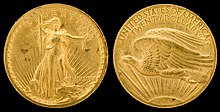
Though the dollar came under the gold standard de jure only after 1900, the bimetallic era was ended de facto when the Coinage Act of 1873 suspended the minting of the standard silverish dollar of 412.5 grains (26.73 g = 0.8595 oz t), the only fully legal tender coin that individuals could convert bullion into in unlimited (or Free silver) quantities,[47] and right at the onset of the silver blitz from the Comstock Lode in the 1870s. This was the so-called "Offense of '73".
The Gilt Standard Deed of 1900 repealed the U.Southward. dollar'southward historic link to silverish and divers information technology solely equally 23.22 grains (1.505 g) of fine gold (or $20.67 per troy ounce of 480 grains). In 1933, aureate coins were confiscated by Executive Order 6102 under Franklin D. Roosevelt, and in 1934 the standard was inverse to $35 per troy ounce fine gold, or xiii.71 grains (0.888 g) per dollar.
After 1968 a serial of revisions to the gold peg was implemented, culminating in the Nixon Stupor of Baronial xv, 1971, which suddenly ended the convertibility of dollars to gold. The U.S. dollar has since floated freely on the foreign commutation markets.
Federal Reserve Notes, 20th century to present [edit]

Obverse of a rare 1934 $500 Federal Reserve Note, featuring a portrait of President William McKinley

Opposite of a $500 Federal Reserve Note
Congress connected to issue paper coin after the Civil War, the latest of which is the Federal Reserve Annotation that was authorized by the Federal Reserve Human action of 1913. Since the discontinuation of all other types of notes (Aureate Certificates in 1933, Silver Certificates in 1963, and Us Notes in 1971), U.Southward. dollar notes have since been issued exclusively every bit Federal Reserve Notes.
Emergence every bit reserve currency [edit]
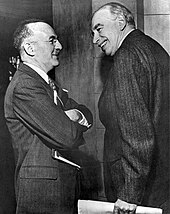
The U.S. dollar outset emerged as an important international reserve currency in the 1920s, displacing the British pound sterling as it emerged from the First Globe War relatively unscathed and since the United States was a significant recipient of wartime gold inflows. After the U.s. emerged as an even stronger global superpower during the Second World War, the Bretton Woods Agreement of 1944 established the U.S. dollar as the globe's primary reserve currency and the only post-war currency linked to gold. Despite all links to gold existence severed in 1971, the dollar continues to be the world'southward foremost reserve currency for international trade to this day.
The Bretton Woods Understanding of 1944 also defined the post-World War II monetary order and relations among modern-day independent states, by setting up a system of rules, institutions, and procedures to regulate the international monetary system. The agreement founded the International Monetary Fund and other institutions of the mod-day World Bank Grouping, establishing the infrastructure for conducting international payments and accessing the global capital markets using the U.S. dollar.
The monetary policy of the United States is conducted by the Federal Reserve System, which acts every bit the nation'south primal bank. Information technology was founded in 1913 under the Federal Reserve Act in gild to furnish an rubberband currency for the United States and to supervise its cyberbanking system, specially in the aftermath of the Panic of 1907.
For near of the post-war period, the U.Southward. authorities has financed its own spending by borrowing heavily from the dollar-lubricated global capital markets, in debts denominated in its own currency and at minimal interest rates. This ability to infringe heavily without facing a significant balance of payments crisis has been described as the United States's exorbitant privilege.
Coins [edit]
The Us Mint has issued legal tender coins every year from 1792 to the present. From 1934 to the present, the only denominations produced for apportionment take been the familiar penny, nickel, dime, quarter, half dollar, and dollar.
| Denomination | Mutual proper noun | Obverse | Reverse | Obverse portrait and blueprint date | Reverse motif and design date | Weight | Bore | Material | Border | Apportionment |
|---|---|---|---|---|---|---|---|---|---|---|
| Cent one¢ | penny |  | Abraham Lincoln (1909) | Wedlock Shield (2010) | 2.v k (0.088 oz) | 0.75 in (nineteen.05 mm) | 97.five% Zn covered by 2.5% Cu | Patently | Wide | |
| Five cents 5¢ | nickel |  | Thomas Jefferson (2006) | Monticello (1938) | 5.0 grand (0.176 oz) | 0.835 in (21.21 mm) | 75% Cu 25% Ni | Plain | Wide | |
| Dime 10¢ | dime |  |  | Franklin D. Roosevelt (1946) | Olive co-operative, torch, and oak branch (1946) | 2.268 g (0.08 oz) | 0.705 in (17.91 mm) | 91.67% Cu 8.33% Ni | 118 reeds | Wide |
| Quarter dollar 25¢ | quarter |  | George Washington (1932) | Washington crossing the Delaware (2021) | 5.67 g (0.two oz) | 0.955 in (24.26 mm) | 91.67% Cu 8.33% Ni | 119 reeds | Broad | |
| Half dollar fifty¢ | half |  |  | John F. Kennedy (1964) | Presidential Seal (1964) | 11.34 yard (0.4 oz) | one.205 in (30.61 mm) | 91.67% Cu viii.33% Ni | 150 reeds | Express |
| Dollar money $ane | dollar coin, golden dollar |  | Contour of Sacagawea with her child | Various; new design per yr | 8.ten thousand (0.286 oz) | one.043 in (26.50 mm) | 88.v% Cu vi% Zn 3.five% Mn 2% Ni | Plain 2000-2006 Lettered 2007-Present | Limited |
Gold and silvery coins have been previously minted for general circulation from the 18th to the 20th centuries. The last gold coins were minted in 1933. The last xc% silverish coins were minted in 1964, and the last 40% silver half dollar was minted in 1970.
The U.s.a. Mint currently produces circulating coins at the Philadelphia and Denver Mints, and commemorative and proof coins for collectors at the San Francisco and W Point Mints. Mint mark conventions for these and for past mint branches are discussed in Coins of the United states of america dollar#Mint marks.
The one-dollar coin has never been in popular circulation from 1794 to present, despite several attempts to increment their usage since the 1970s, the most important reason of which is the continued production and popularity of the i-dollar bill.[48] Half dollar coins were commonly used currency since inception in 1794, but has fallen out of employ from the mid-1960s when all silver one-half dollars began to exist hoarded.
The nickel is the only coin whose size and limerick (5 grams, 75% copper, and 25% nickel) is still in use from 1865 to today, except for wartime 1942-1945 Jefferson nickels which independent silverish.
Due to the penny's low value, some efforts have been made to eliminate the penny as circulating coinage. [49] [fifty]
For a discussion of other discontinued and canceled denominations, come across Obsolete denominations of United States currency#Coinage and Canceled denominations of The states currency#Coinage.
Collector coins [edit]
Collector coins are technically legal tender at face up value but are usually worth far more due to their numismatic value or for their precious metal content. These include:
- American Eagle bullion coins
- American Silver Hawkeye $ane (1 troy oz) Silver bullion coin 1986–nowadays
- American Gilded Hawkeye $5 ( 1⁄10 troy oz), $10 ( 1⁄4 troy oz), $25 ( ane⁄2 troy oz), and $fifty (ane troy oz) Gilt bullion coin 1986–present
- American Platinum Eagle $10 ( 1⁄10 troy oz), $25 ( 1⁄4 troy oz), $50 ( 1⁄2 troy oz), and $100 (1 troy oz) Platinum bullion coin 1997–present
- American Palladium Eagle $25 (1 troy oz) Palladium bullion money 2017–present
- The states commemorative coins—special event coins, among these:
- $l.00 (Half Union) minted for the Panama-Pacific International Exposition (1915)
- Silver proof sets minted since 1992 with dimes, quarters and half-dollars made of silver rather than the standard copper-nickel
- Presidential dollar coins proof sets minted since 2007
Banknotes [edit]
| Denomination | Front | Reverse | Portrait | Reverse motif | First series | Latest series | Circulation |
|---|---|---|---|---|---|---|---|
| One dollar | 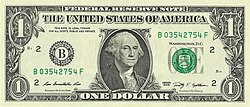 |  | George Washington | Groovy Seal of the United States | Series 1963[d] Series 1935[eastward] | Series 2017A[51] | Wide |
| 2 dollars |  |  | Thomas Jefferson | Announcement of Independence by John Trumbull | Series 1976 | Series 2017A | Wide |
| Five dollars | 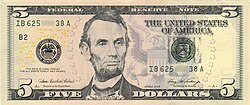 | 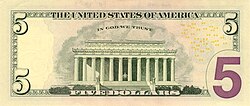 | Abraham Lincoln | Lincoln Memorial | Series 2006 | Serial 2017A | Wide |
| 10 dollars | 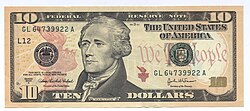 | 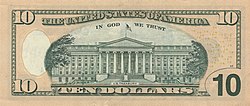 | Alexander Hamilton | U.S. Treasury | Serial 2004A | Series 2017A | Wide |
| Twenty dollars |  | 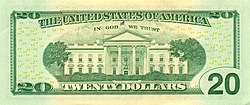 | Andrew Jackson | White House | Serial 2004 | Serial 2017A | Broad |
| Fifty dollars | 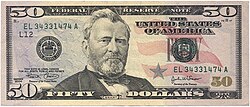 | 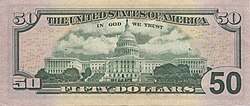 | Ulysses South. Grant | The states Capitol | Series 2004 | Series 2017A | Broad |
| One hundred dollars |  |  | Benjamin Franklin | Independence Hall | Serial 2009A[52] | Series 2017A | Wide |
The U.S. Constitution provides that Congress shall have the ability to "borrow money on the credit of the United States."[53] Congress has exercised that power past authorizing Federal Reserve Banks to issue Federal Reserve Notes. Those notes are "obligations of the United states" and "shall be redeemed in lawful money on need at the Treasury Department of the United States, in the metropolis of Washington, District of Columbia, or at any Federal Reserve bank".[54] Federal Reserve Notes are designated by police force as "legal tender" for the payment of debts.[55] Congress has too authorized the issuance of more 10 other types of banknotes, including the United States Note[56] and the Federal Reserve Depository financial institution Note. The Federal Reserve Note is the only type that remains in apportionment since the 1970s.
Federal Reserve Notes are printed by the Agency of Engraving and Printing and are made from cotton fiber newspaper (as opposed to forest cobweb used to make common newspaper). The "large-sized notes" issued earlier 1928 measured seven.42 in × 3.125 in (188.5 mm × 79.4 mm), while small-sized notes introduced that yr mensurate 6.14 in × 2.61 in × 0.0043 in (155.96 mm × 66.29 mm × 0.11 mm).[57] The dimensions of the modernistic (pocket-sized-size) U.S. currency is identical to the size of Philippine peso banknotes issued under Us administration later on 1903, which had proven highly successful.[58] The American large-note bills became known as "horse blankets" or "saddle blankets."[59]
Currently printed denominations are $1, $ii, $5, $10, $20, $50, and $100. Notes in a higher place the $100 denomination stopped being printed in 1946 and were officially withdrawn from apportionment in 1969. These notes were used primarily in inter-bank transactions or by organized crime; it was the latter usage that prompted President Richard Nixon to consequence an executive lodge in 1969 halting their utilise. With the appearance of electronic banking, they became less necessary. Notes in denominations of $500, $one,000, $5,000, $10,000, and $100,000 were all produced at one time; come across large denomination bills in U.S. currency for details. With the exception of the $100,000 bill (which was merely issued as a Serial 1934 Gold Certificate and was never publicly circulated; thus it is illegal to own), these notes are at present collectors' items and are worth more than their face up value to collectors.
Though still predominantly green, the postal service-2004 series comprise other colors to better distinguish unlike denominations. As a outcome of a 2008 decision in an accessibility lawsuit filed past the American Quango of the Blind, the Bureau of Engraving and Press is planning to implement a raised tactile feature in the next redesign of each note, except the $1 and the current version of the $100 bill. It as well plans larger, college-contrast numerals, more than colour differences, and distribution of currency readers to aid the visually impaired during the transition period.[60]
Monetary policy [edit]
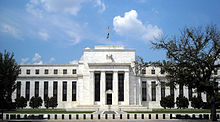
The Federal Reserve Human activity created the Federal Reserve System in 1913 as the central banking company of the United States. Its primary task is to conduct the nation's monetary policy to promote maximum employment, stable prices, and moderate long-term interest rates in the U.Due south. economic system. Information technology is also tasked to promote the stability of the financial system and regulate fiscal institutions, and to human activity equally lender of last resort.[61] [62]
The Monetary policy of the U.s.a. is conducted past the Federal Open up Market Commission, which is composed of the Federal Reserve Board of Governors and 5 out of the 12 Federal Reserve Bank presidents, and is implemented past all twelve regional Federal Reserve Banks.
Monetary policy refers to deportment made by fundamental banks that determine the size and growth charge per unit of the money supply available in the economy, and which would issue in desired objectives like depression inflation, low unemployment, and stable financial systems. The economy'due south aggregate coin supply is the total of
- M0 money, or Monetary Base - "dollars" in currency and bank coin balances credited to the central bank's depositors, which are backed by the central bank's avails,
- plus M1, M2, M3 money - "dollars" in the class of banking company coin balances credited to banks' depositors, which are backed past the bank's assets and investments.
The FOMC influences the level of money available to the economic system by the post-obit means:
- Reserve requirements - specifies a required minimum pct of deposits in a commercial bank that should be held as a reserve (i.east. equally deposits with the Federal Reserve), with the rest available to loan or invest. Higher requirements mean less money loaned or invested, helping keep aggrandizement in check. Raising the federal funds rate earned on those reserves also helps achieve this objective.
- Open market operations - the Federal Reserve buys or sells United states of america Treasury bonds and other securities held by banks in exchange for reserves; more reserves increase a banking concern'southward chapters to loan or invest elsewhere.
- Disbelieve window lending - banks tin can borrow from the Federal Reserve.
Monetary policy straight affects involvement rates; it indirectly affects stock prices, wealth, and currency commutation rates. Through these channels, monetary policy influences spending, investment, production, employment, and aggrandizement in the Us. Constructive monetary policy complements fiscal policy to support economical growth.
The adjusted monetary base has increased from approximately $400 billion in 1994, to $800 billion in 2005, and to over $3,000 billion in 2013.[63]
When the Federal Reserve makes a buy, it credits the seller's reserve account (with the Federal Reserve). This money is not transferred from any existing funds—it is at this bespeak that the Federal Reserve has created new high-powered money. Commercial banks so determine how much coin to keep in deposit with the Federal Reserve and how much to hold as physical currency. In the latter case, the Federal Reserve places an order for printed money from the U.S. Treasury Department.[64] The Treasury Department, in plow, sends these requests to the Bureau of Engraving and Printing (to print new dollar bills) and the Bureau of the Mint (to postage the coins).
The Federal Reserve'south budgetary policy objectives to go on prices stable and unemployment low is frequently chosen the dual mandate. This replaces past practices under a gold standard where the master concern is the gilded equivalent of the local currency, or nether a gold exchange standard where the business organization is fixing the commutation rate versus some other gilt-convertible currency (previously practiced worldwide nether the Bretton Woods Agreement of 1944 via stock-still exchange rates to the U.S. dollar).
International use as reserve currency [edit]
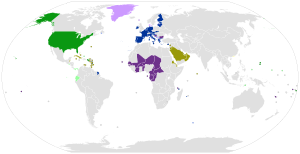
Worldwide use of the U.S. dollar:
The states
External adopters of the US dollar
Currencies pegged to the US dollar
Currencies pegged to the United states of america dollar w/ narrow band
Worldwide use of the euro:
External adopters of the euro
Currencies pegged to the euro
Currencies pegged to the euro w/ narrow ring
Ascendancy [edit]
The main currency used for global trade between Europe, Asia, and the Americas has historically been the Spanish-American silver dollar, which created a global silver standard arrangement from the 16th to 19th centuries, due to arable silvery supplies in Spanish America.[65] The U.S. dollar itself was derived from this coin. The Spanish dollar was later displaced by the British pound sterling in the advent of the international gold standard in the last quarter of the 19th century.
The U.S. dollar began to readapt the pound sterling as international reserve currency from the 1920s since it emerged from the First Earth War relatively unscathed and since the Us was a significant recipient of wartime gold inflows.[66] After the U.S. emerged equally an fifty-fifty stronger global superpower during the Second World War, the Bretton Woods Agreement of 1944 established the post-state of war international monetary system, with the U.S. dollar ascending to become the globe's primary reserve currency for international trade, and the only post-state of war currency linked to gold at $35 per troy ounce.[67] Despite all links to aureate being severed in 1971, the dollar continues to play this role to this twenty-four hours.
As international reserve currency [edit]
The U.S. dollar is joined by the earth's other major currencies - the euro, pound sterling, Japanese yen and Chinese renminbi - in the currency handbasket of the special drawing rights of the International Budgetary Fund. Central banks worldwide have huge reserves of U.South. dollars in their holdings and are meaning buyers of U.S. treasury bills and notes.[68]
Foreign companies, entities, and private individuals hold U.South. dollars in strange deposit accounts called eurodollars (not to exist confused with the euro), which are outside the jurisdiction of the Federal Reserve System. Private individuals also hold dollars exterior the banking system more often than not in the form of U.s.a.$100 bills, of which eighty% of its supply is held overseas.
The United States Department of the Treasury exercises considerable oversight over the SWIFT financial transfers network,[69] and consequently has a huge sway on the global financial transactions systems, with the ability to impose sanctions on foreign entities and individuals.[70]
In the global markets [edit]
The U.S. dollar is predominantly the standard currency unit in which appurtenances are quoted and traded, and with which payments are settled in, in the global commodity markets.[71] The U.S. Dollar Index is an of import indicator of the dollar'southward strength or weakness versus a basket of six foreign currencies.
The United States Regime is capable of borrowing trillions of dollars from the global capital markets in U.S. dollars issued by the Federal Reserve, which is itself under U.S. government purview, at minimal interest rates, and with virtually cypher default hazard. In contrast, strange governments and corporations incapable of raising coin in their own local currencies are forced to upshot debt denominated in U.S. dollars, along with its consistent higher interest rates and risks of default.[72] The United States'southward ability to borrow in its own currency without facing a significant remainder of payments crisis has been frequently described as its exorbitant privilege.[73]
A frequent topic of debate is whether the strong dollar policy of the Us is indeed in America's own all-time interests, besides equally in the best involvement of the international community.[74]
Currencies fixed to the U.Southward. dollar [edit]
For a more exhaustive give-and-take of countries using the U.South. dollar as official or customary currency, or using currencies which are pegged to the U.S. dollar, see International use of the U.S. dollar#Dollarization and fixed exchange rates and Currency substitution#Us dollar.
Countries using the U.Due south. dollar as its official currency include:
- In the Americas: Panama, Ecuador, Republic of el salvador, British Virgin Islands, Turks and Caicos Islands, and the Caribbean area Netherlands.
- The elective states of the old Trust Territory of the Pacific Islands: Palau, the Federated States of Micronesia, and the Marshall islands.
- Others: East Timor.
Among the countries using the U.Southward. dollar together with other strange currencies and its local currency are Kingdom of cambodia and Zimbabwe.
Currencies pegged to the U.S. dollar include:
- In the Caribbean: the Bahamian dollar, Barbadian dollar, Belize dollar, Bermudan dollar, Cayman Islands dollar, E Caribbean dollar, Netherlands Antillean guilder and the Aruban florin.
- The currencies of the oil-producing Arab countries: the Saudi riyal, United Arab Emirates dirham, Omani rial, Qatari riyal and the Bahraini dinar.
- Others: the Hong Kong dollar, Macanese pataca, Lebanese Pound .
Value [edit]
|
|
|

U.Southward. Consumer Price Index, starting from 1913
The 6th paragraph of Section 8 of Commodity 1 of the U.S. Constitution provides that the U.S. Congress shall have the power to "coin money" and to "regulate the value" of domestic and foreign coins. Congress exercised those powers when it enacted the Coinage Act of 1792. That Act provided for the minting of the first U.S. dollar and information technology declared that the U.S. dollar shall have "the value of a Spanish milled dollar as the same is now current".[75]
The tabular array above shows the equivalent amount of goods that, in a particular twelvemonth, could exist purchased with $1. The table shows that from 1774 through 2012 the U.Due south. dollar has lost virtually 97.0% of its buying power.[76]
The decline in the value of the U.S. dollar corresponds to price inflation, which is a rise in the general level of prices of goods and services in an economy over a menstruum of time.[77] A consumer price index (CPI) is a measure estimating the average price of consumer goods and services purchased by households. The United states of america Consumer Price Alphabetize, published by the Bureau of Labor Statistics, is a measure estimating the average price of consumer goods and services in the The states.[78] It reflects inflation equally experienced past consumers in their day-to-day living expenses.[79] A graph showing the U.S. CPI relative to 1982–1984 and the almanac yr-over-year alter in CPI is shown at right.
The value of the U.S. dollar declined significantly during wartime, especially during the American Civil War, Globe War I, and Globe State of war II.[fourscore] The Federal Reserve, which was established in 1913, was designed to furnish an "rubberband" currency field of study to "substantial changes of quantity over curt periods", which differed significantly from previous forms of high-powered coin such as golden, national banknotes, and silver coins.[81] Over the very long run, the prior gold standard kept prices stable—for instance, the price level and the value of the U.Southward. dollar in 1914 were non very dissimilar from the toll level in the 1880s. The Federal Reserve initially succeeded in maintaining the value of the U.S. dollar and price stability, reversing the aggrandizement caused by the First World War and stabilizing the value of the dollar during the 1920s, before presiding over a 30% deflation in U.S. prices in the 1930s.[82]
Nether the Bretton Forest system established after Globe State of war 2, the value of gold was stock-still to $35 per ounce, and the value of the U.S. dollar was thus anchored to the value of gold. Rising regime spending in the 1960s, however, led to doubts near the power of the United states of america to maintain this convertibility, gold stocks dwindled every bit banks and international investors began to catechumen dollars to gold, and as a result, the value of the dollar began to decline. Facing an emerging currency crunch and the imminent danger that the United States would no longer be able to redeem dollars for gold, gold convertibility was finally terminated in 1971 by President Nixon, resulting in the "Nixon shock".[83]
The value of the U.Due south. dollar was therefore no longer anchored to gold, and it vicious upon the Federal Reserve to maintain the value of the U.S. currency. The Federal Reserve, however, continued to increment the money supply, resulting in stagflation and a rapidly declining value of the U.South. dollar in the 1970s. This was largely due to the prevailing economical view at the time that inflation and real economic growth were linked (the Phillips curve), and so inflation was regarded as relatively beneficial.[83] Betwixt 1965 and 1981, the U.S. dollar lost two thirds of its value.[76]
In 1979, President Carter appointed Paul Volcker Chairman of the Federal Reserve. The Federal Reserve tightened the coin supply and inflation was substantially lower in the 1980s, and hence the value of the U.Southward. dollar stabilized.[83]
Over the 30-yr flow from 1981 to 2009, the U.S. dollar lost over half its value.[76] This is because the Federal Reserve has targeted not zippo inflation, but a low, stable rate of aggrandizement—between 1987 and 1997, the rate of aggrandizement was approximately 3.five%, and between 1997 and 2007 it was approximately ii%. The so-called "Dandy Moderation" of economical atmospheric condition since the 1970s is credited to monetary policy targeting price stability.[84]
At that place is an ongoing contend most whether central banks should target zero inflation (which would mean a abiding value for the U.S. dollar over time) or low, stable inflation (which would hateful a continuously but slowly declining value of the dollar over time, as is the example at present). Although some economists are in favor of a nix inflation policy and therefore a constant value for the U.Southward. dollar,[82] others debate that such a policy limits the power of the central bank to control interest rates and stimulate the economy when needed.[85]
Commutation rates [edit]
Historical commutation rates [edit]
| Currency units | 1970[i] | 1980[i] | 1985[i] | 1990[i] | 1993 | 1999 | 2000 | 2001 | 2002 | 2003 | 2004 | 2005 | 2006 | 2007 | 2008 | 2009 | 2010 | 2011 | 2012 | 2013 | 2014 | 2015 | 2018[89] |
|---|---|---|---|---|---|---|---|---|---|---|---|---|---|---|---|---|---|---|---|---|---|---|---|
| Euro | — | — | — | — | — | 0.9387 | 1.0832 | 1.1171 | 1.0578 | 0.8833 | 0.8040 | 0.8033 | 0.7960 | 0.7293 | 0.6791 | 0.7176 | 0.6739 | 0.7178 | 0.7777 | 0.7530 | 0.7520 | 0.9015 | 0.8504 |
| Japanese yen | 357.6 | 240.45 | 250.35 | 146.25 | 111.08 | 113.73 | 107.80 | 121.57 | 125.22 | 115.94 | 108.xv | 110.eleven | 116.31 | 117.76 | 103.39 | 93.68 | 87.78 | 79.lxx | 79.82 | 97.60 | 105.74 | 121.05 | 111.130 |
| Pound sterling | 8s 4d =0.4167 | 0.4484[two] | 0.8613[ii] | 0.6207 | 0.6660 | 0.6184 | 0.6598 | 0.6946 | 0.6656 | 0.6117 | 0.5456 | 0.5493 | 0.5425 | 0.4995 | 0.5392 | 0.6385 | 0.4548 | 0.6233 | 0.6308 | 0.6393 | 0.6066 | 0.6544 | 0.7454 |
| Swiss franc | 4.12 | 1.68 | two.46[90] | 1.39 | 1.48 | one.50 | ane.69 | 1.69 | one.62 | 1.40 | 1.24 | i.15 | 1.29 | ane.23 | 1.12 | 1.08 | ane.03 | 0.93 | 0.93 | 0.90 | 0.92 | 1.00 | 0.98 |
| Canadian dollar[91] | 1.081 | i.168 | 1.321 | i.1605 | 1.2902 | 1.4858 | 1.4855 | i.5487 | 1.5704 | 1.4008 | one.3017 | 1.2115 | 1.1340 | 1.0734 | 1.0660 | 1.1412 | 1.0298 | 0.9887 | 0.9995 | 1.0300 | 1.1043 | 1.2789 | ane.2842 |
| Mexican peso[92] | 0.01250–0.02650[3] | ii.eighty[iii] | 2.67[three] | 2.50[3] | three.1237 | nine.553 | 9.459 | ix.337 | 9.663 | 10.793 | 11.290 | x.894 | 10.906 | 10.928 | xi.143 | xiii.498 | 12.623 | 12.427 | 13.154 | 12.758 | xiii.302 | 15.837 | 19.911 |
| Chinese Renminbi[93] | 2.46 | i.7050 | 2.9366 | iv.7832 | five.7620 | 8.2783 | 8.2784 | viii.2770 | 8.2771 | 8.2772 | 8.2768 | 8.1936 | 7.9723 | vii.6058 | 6.9477 | 6.8307 | 6.7696 | 6.4630 | 6.3093 | vi.1478 | 6.1620 | 6.2840 | 6.383 |
| Pakistani rupee | four.761 | 9.9 | 15.9284 | 21.707 | 28.107 | 51.9 | 51.9 | 63.v | threescore.5 | 57.75 | 57.8 | 59.7 | 60.4 | threescore.83 | 67 | 80.45 | 85.75 | 88.half dozen | 90.seven | 105.477 | 100.661 | 104.763 | 139.850 |
| Indian rupee | 7.56 | 8.000 | 12.38 | sixteen.96 | 31.291 | 43.13 | 45.00 | 47.22 | 48.63 | 46.59 | 45.26 | 44.00 | 45.19 | 41.18 | 43.39 | 48.33 | 45.65 | 46.58 | 53.37 | 58.51 | 62.00 | 64.1332 | 68.11 |
| Singapore dollar | — | — | 2.179 | one.903 | i.6158 | 1.6951 | one.7361 | 1.7930 | i.7908 | one.7429 | 1.6902 | one.6639 | 1.5882 | i.5065 | 1.4140 | 1.4543 | 1.24586 | ane.2565 | i.2492 | 1.2511 | 1.2665 | i.3748 | 1.343 |
Current exchange rates [edit]
| Current USD exchange rates | |
|---|---|
| From Google Finance: | AUD CAD CHF CNY EUR GBP HKD JPY MXN TWD KRW |
| From Yahoo! Finance: | AUD CAD CHF CNY EUR GBP HKD JPY MXN TWD KRW |
| From XE.com: | AUD CAD CHF CNY EUR GBP HKD JPY MXN TWD KRW |
| From OANDA: | AUD CAD CHF CNY EUR GBP HKD JPY MXN TWD KRW |
See also [edit]
- Apocryphal United States currency
- Dedollarisation
- International use of the U.S. dollar
- List of the largest trading partners of the United states of america
- Monetary policy of the United States
- Petrodollar recycling
- Strong dollar policy
- U.Due south. Dollar Index
Notes [edit]
- ^ Aslope East timor centavo coins
- ^ Alongside Ecuadorian centavo coins
- ^ Alongside Bitcoin
- ^ Obverse
- ^ Reverse
- ^ a b c d Mexican peso values prior to 1993 revaluation
- ^ a b 1970–1992. 1980 derived from AUD–USD=ane.1055 and AUD–GBP=0.4957 at end of December 1979: 0.4957/1.1055=0.448394392; 1985 derived from AUD–USD=0.8278 and AUD–GBP=0.7130 at terminate of December 1984: 0.7130/0.8278=0.861319159.
- ^ a b c d Value at the start of the year
References [edit]
- ^ "Coinage Act of 1792" (PDF). The states Congress. Archived from the original (PDF) on April seven, 2004. Retrieved April ii, 2008.
- ^ Nay Im, Tal; Dabadie, Michel (March 31, 2007). "Dollarization in Cambodia" (PDF). National Banking concern of Kingdom of cambodia . Retrieved Apr 11, 2022.
- ^ Nagumo, Jada (August 4, 2021). "Cambodia aims to wean off U.s.a. dollar dependence with digital currency". Nikkei Asia. Retrieved April 11, 2022.
Cambodia runs a dual-currency system, with the U.S. dollar widely circulating in its economy. The country's dollarization began in the 1980s and 90s, following years of civil war and unrest.
- ^ "Central Banking company of Timor-Leste". Retrieved March 22, 2017.
The official currency of Timor-Leste is the United States dollar, which is legal tender for all payments made in cash.
- ^ "Ecuador". CIA Earth Factbook. October 18, 2010. Retrieved October 17, 2018.
The dollar is legal tender
- ^ "Republic of el salvador". CIA World Factbook. October 21, 2010. Retrieved October 17, 2018.
The US dollar became El Salvador'due south currency in 2001
- ^ "Nixon Ends Convertibility of U.s.a. Dollars to Gold and Announces Wage/Price Controls". Federal Reserve Bank of Richmond. Retrieved October 17, 2018.
- ^ "The Implementation of Monetary Policy – The Federal Reserve in the International Sphere" (PDF) . Retrieved October 17, 2018.
- ^ Cohen, Benjamin J. 2006. The Time to come of Money, Princeton Academy Printing. ISBN 0-691-11666-0.
- ^ Agar, Charles. 2006. Vietnam, (Frommer's). ISBN 0-471-79816-9. p. 17: "the dollar is the de facto currency in Cambodia."
- ^ "How much U.South. currency is in circulation?". Federal Reserve. Retrieved February 27, 2021.
- ^ U.S. Constitution, Article 1, Section 8. para. five.
- ^ a b c Denominations, specifications, and blueprint of coins. 31 U.S.C. § 5112.
- ^ U.Due south. Constitution, Article 1, Section 9. para. 7.
- ^ Reports. 31 U.S.C. § 331.
- ^ "Fiscal Report of the United States Regime" (PDF). Department of the Treasury. 2009. Archived from the original (PDF) on November 13, 2018. Retrieved October 17, 2018.
- ^ a b U.S. Congress. 1792. Coinage Human action of 1792. 2nd Congress, 1st Session. Sec. 9, ch. 16. Retrieved 6 June 2020.
- ^ a b Fitzpatrick, John C., ed. (1934). "Tuesday, August 8, 1786". Journals of the Continental Congress 1774-1789. XXXI: 1786: 503–505. Retrieved Dec 5, 2019.
- ^ Peters, Richard, ed. (1845). "Second Congress. Sess. I. Ch. sixteen". The Public Statues at Large of the Us of America, Etc. Etc. one: 246–251. Retrieved December 5, 2019.
- ^ Langland, Connie (May 27, 2015). "What is a millage rate and how does it affect school funding?". WHYY. PBS and NPR. Retrieved December 5, 2019.
- ^ a b "Mills Currency". Past & Present. Postage stamp and Coin Identify Blog. September 26, 2018. Archived from the original on May three, 2021. Retrieved December 5, 2019.
- ^ a b "How much is "2 $.25" and where did the phrase".
- ^ "Decimal Trading Definition and History".
- ^ Mehl, B. Max. "United States $l.00 Aureate Pieces, 1877", in Star Rare Coins Encyclopedia and Premium Catalogue (20th edition, 1921)
- ^ a b "Inquire United states of america." National Geographic. June 2002. p. ane.
- ^ There's no solid reference on the desirability of liondollars in North America and on 1:one parity with heavier dollars. A dollar worth $0.eighty Spanish is non inexpensive if priced at $0.50 http://coins.lakdiva.org/netherlands/1644_wes_lion_daalder_ag.html https://coins.nd.edu/ColCoin/ColCoinIntros/Lion-Dollar.intro.html
- ^ "Buck". Online Etymology Dictionary . Retrieved Oct 17, 2018.
- ^ "Newspaper Coin Glossary". Littleton Coin Visitor. Retrieved October 17, 2018.
- ^ Scutt, David (June 3, 2019). "The Australian dollar is grinding higher as expectations for rate cuts from the US Federal Reserve build". Business organization Insider . Retrieved Baronial 7, 2019.
- ^ Tappe, Anneken (August 9, 2018). "New Zealand dollar leads G-10 losers as greenback gains strengt". MarketWatch . Retrieved August 7, 2019.
- ^ "UPDATE 1-South Africa'south rand firms confronting greenback, stocks rise". Reuters . Retrieved August 7, 2019. [ dead link ]
- ^ "Why rupee is one time again under pressure". Business organisation Today. Apr 22, 2019. Retrieved August 7, 2019.
- ^ Cajori, Florian ([1929]1993). A History of Mathematical Notations (Vol. 2). New York: Dover, 15–29. ISBN 0-486-67766-4
- ^ Aiton, Arthur Due south.; Wheeler, Benjamin W. (1931). "The Beginning American Mint". The Hispanic American Historical Review. 11 (2). p. 198 and note two on p. 198. doi:ten.1215/00182168-11.ii.198. JSTOR 2506275.
- ^ Nussbaum, Arthur (1957). A History of the Dollar . New York: Columbia University Press. p. 56.
The dollar sign, $, is connected with the peso, contrary to popular belief, which considers it to be an abbreviation of 'U.Due south.' The two parallel lines represented i of the many abbreviations of 'P,' and the 'S' indicated the plural. The abbreviation '$.' was besides used for the peso, and is even so used in Argentina.
- ^ "U.S. Agency of Engraving and Printing - FAQs". www.bep.gov.
- ^ Rand, Ayn. [1957] 1992. Atlas Shrugged. Signet. p. 628.
- ^ James, James Alton (1970) [1937]. Oliver Pollock: The Life and Times of an Unknown Patriot. Freeport: Books for Libraries Printing. p. 356. ISBN978-0-8369-5527-9.
- ^ Mint, U.S. "Coinage Act of 1792". U.S. treasury.
- ^ Come across [1].
- ^ Sumner, W. G. (1898). "The Spanish Dollar and the Colonial Shilling". The American Historical Review. iii (four): 607–619. doi:10.2307/1834139. JSTOR 1834139.
- ^ "Us Dollar". OANDA. Retrieved October 17, 2018.
- ^ "Engraving and printing currency and security documents:Commodity b". Legal Data Establish. Retrieved December 19, 2013.
- ^ Matt Soniak (July 22, 2011). "On the Money: Everything Yous Ever Wanted to Know Nearly Coin Portraits". Mental Floss . Retrieved October 17, 2018.
- ^ Newman, Eric P. (1990). The Early Newspaper Money of America (3 ed.). Iola, Wisconsin: Krause Publications. p. 17. ISBN0-87341-120-X.
- ^ Wright, Robert E. (2008). One Nation Under Debt: Hamilton, Jefferson, and the History of What We Owe. New York, New York: McGraw-Hill. pp. 50–52. ISBN978-0-07-154393-iv.
- ^ Silvery bullion can be converted in unlimited quantities of Trade dollars of 420 grains, but these were meant for export and had legal tender limits in the United states of america. See Trade dollar (United States coin).
- ^ Anderson, Gordon T. 25 April 2005. "Congress tries again for a dollar coin." CNN Money.
- ^ Christian Zappone (July 18, 2006). "Kill-the-penny bill introduced". CNN Money . Retrieved October 17, 2018.
- ^ Weinberg, Ali (February 19, 2013). "Penny pinching: Tin Obama manage emptying of ane-cent coin?". NBC News. Retrieved Oct 17, 2018.
- ^ "USPaperMoney.Info: Series 2017A $1". www.uspapermoney.info.
- ^ "$100 Note | U.Southward. Currency Education Program".
- ^ "Paragraph ii of Department 8 of Commodity 1 of the The states Constitution". Topics.police force.cornell.edu. Retrieved Oct 17, 2018.
- ^ "Section 411 of Championship 12 of the U.s. Code". Law.cornell.edu. June 22, 2010. Retrieved Oct 17, 2018.
- ^ "Section 5103 of Championship 31 of the The states Code". Law.cornell.edu. August six, 2010. Retrieved October 17, 2018.
- ^ "Department 5115 of Title 31 of the United States Lawmaking". Police force.cornell.edu. Baronial half dozen, 2010. Retrieved October 17, 2018.
- ^ "Treasury Department Appropriation Bill for 1929: Hearing Before the Subcommittee of House Committee on Appropriations... Seventieth Congress, Showtime Session". 1928.
- ^ Schwarz, John; Lindquist, Scott (September 21, 2009). Standard Guide to Pocket-sized-Size U.Southward. Paper Coin - 1928-Date. ISBN9781440225789.
- ^ Orzano, Michele. "What is a equus caballus blanket note?". Coin World. Coin Earth. Retrieved November 29, 2021.
- ^ See Federal Reserve Note for details and references
- ^ "Federal Reserve Board - Purposes & Functions".
- ^ "Conducting Monetary Policy" (PDF). The states Federal Reserve. Retrieved August 23, 2021.
{{cite web}}: CS1 maint: url-status (link) - ^ "St. Louis Adapted Monetary Base of operations". Federal Reserve Depository financial institution of St. Louis. Feb xv, 1984. Retrieved October 17, 2018.
- ^ "Fact Sheets: Currency & Coins". United states of america Department of the Treasury. Retrieved Oct 17, 2018.
- ^ "'The Silver Manner' Explains How the Old Mexican Dollar Inverse the Earth". April 30, 2017.
- ^ Eichengreen, Barry; Flandreau, Marc (2009). "The rise and fall of the dollar (or when did the dollar supersede sterling as the leading reserve currency?)". European Review of Economic History. 13 (iii): 377–411. doi:10.1017/S1361491609990153. ISSN 1474-0044. S2CID 154773110.
- ^ "How a 1944 Agreement Created a New Globe Gild".
- ^ "Major foreign holders of U.S. Treasury securities 2021".
- ^ "SWIFT oversight".
- ^ "Sanctions Programs and Land Data | U.S. Department of the Treasury".
- ^ "Touch of the Dollar on Article Prices".
- ^ "Dollar Bond".
- ^ "The dollar's international role: An "exorbitant privilege"?". November 30, 2001.
- ^ Mohsin, Saleha (January 21, 2021). "The Strong Dollar". Bloomberg . Retrieved Baronial 23, 2021.
{{cite news}}: CS1 maint: url-status (link) - ^ "Section 9 of the Coinage Deed of 1792". Memory.loc.gov. Retrieved August 24, 2010.
- ^ a b c "Measuring Worth – Purchasing Ability of Coin in the United States from 1774 to 2010". Retrieved April 22, 2010.
- ^ Olivier Blanchard (2000). Macroeconomics (2nd ed.), Englewood Cliffs, North.J: Prentice Hall, ISBN 0-13-013306-10
- ^ "Consumer Price Alphabetize Oftentimes Asked Questions". Retrieved October 16, 2018.
- ^ "Consumer Cost Index Often Asked Questions". Retrieved October 17, 2018.
- ^ Milton Friedman, Anna Jacobson Schwartz (November 21, 1971). A monetary history of the United States, 1867–1960. p. 546. ISBN978-0691003542.
- ^ Friedman 189–190
- ^ a b "Central Cyberbanking—Then and Now". Retrieved October 17, 2018.
- ^ a b c "Controlling Inflation: A Historical Perspective" (PDF). Archived from the original (PDF) on Dec 7, 2010. Retrieved July 17, 2010.
- ^ "Monetary Brownie, Inflation, and Economic Growth". Retrieved July 17, 2010.
- ^ "U.Due south. Monetary Policy: The Fed's Goals". Retrieved October 17, 2018.
- ^ U.South. Federal Reserve: Final 4 years, 2009–2012, 2005–2008, 2001–2004, 1997–2000, 1993–1996; Reserve Bank of Australia: 1970–present
- ^ 2004–present
- ^ "FRB: Foreign Exchange Rates – G.5A; Release Dates". Board of Governors of the Federal Reserve System. Retrieved July 23, 2014.
- ^ "Historical Substitution Rates Currency Converter". TransferMate.com.
- ^ "Exchange Rates Betwixt the United States Dollar and the Swiss Franc." Measuring Worth. Retrieved October 17, 2018.
- ^ 1977–1991
- ^ 1976–1991
- ^ 1974–1991, 1993–1995
Further reading [edit]
- Prasad, Eswar S. (2014). The Dollar Trap: How the U.S. Dollar Tightened Its Grip on Global Finance. Princeton, NJ: Princeton Academy Printing. ISBN978-0-691-16112-9.
External links [edit]
- U.S. Bureau of Engraving and Printing Archived May 30, 1997, at the Wayback Machine
- U.Due south. Currency and Money Outstanding and in Circulation
- American Currency Exhibit at the San Francisco Federal Reserve Bank
- Relative values of the U.S. dollar, from 1774 to present
- Historical Currency Converter
- Summary of BEP Product Statistics
Images of U.S. currency and coins [edit]
- U.S. Currency Education Plan page with images of all current banknotes
- U.South. Mint: Image Library
- Historical and current banknotes of the U.s.a. (in English and German language)
What Is 70 Euros In Us Dollars,
Source: https://en.wikipedia.org/wiki/United_states_dollar
Posted by: johnsonwhostell68.blogspot.com






0 Response to "What Is 70 Euros In Us Dollars"
Post a Comment